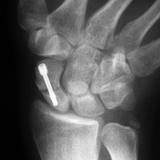Climber’s finger, like many injuries that can affect the hand and arm can occur from trauma but frequently develops from repetitive overuse. Because of the cause and nature of the injury it is difficult for the individual to stop the activity to allow the needed time to heal. With climber’s finger the problem develops from the forceful and repetitive use of one or more fingers, commonly the long finger for a fingertip hold. The injury can range from inflammation to a significant injury to the small but crucial pulleys and sheath that support the flexor tendons in the finger.
To slow the damage and inflammation, standard initial measures can help (ice, rest and activity restriction). Taping encircling the middle section (middle phalynx) of the involved fingers can support the most commonly injured pulley. If there is some relief in symptoms with these measures, then there is good reason to expect that with time the area will heal. Hand therapy can help to control symptoms and encourage healing. Such efforts are aimed at decreasing the inflammation while encouraging healing of any damaged structures. If symptoms respond then the injury is partial and most likely at the inflammatory end of the spectrum of such injuries.
With persistent pain and swelling, or if there is any sense that the tendon on the under surface of the finger is “loose” (pulls away from the finger like the line on a fishing rod when you’ve caught a big one!) more significant injury has likely occurred. An expert evaluation is needed. After examination by your hand specialist, an MRI scan or Ultrasound evaluation may be recommended in order to clarify the extent of injury. The physical exam and imaging studies can determine what is inflamed and what might be torn. If the injury to the pulley that supports the tendon is complete or near-complete then it cannot heal fully on its own and surgical reconstruction will be recommended.
This information is provided on the basis of a presumed conditions: “climber’s finger”. Many conditions can mimic the inflammation and swelling seen with climbing and my have different treatments and outcomes.
Take care,
Greg Balourdas, MD

